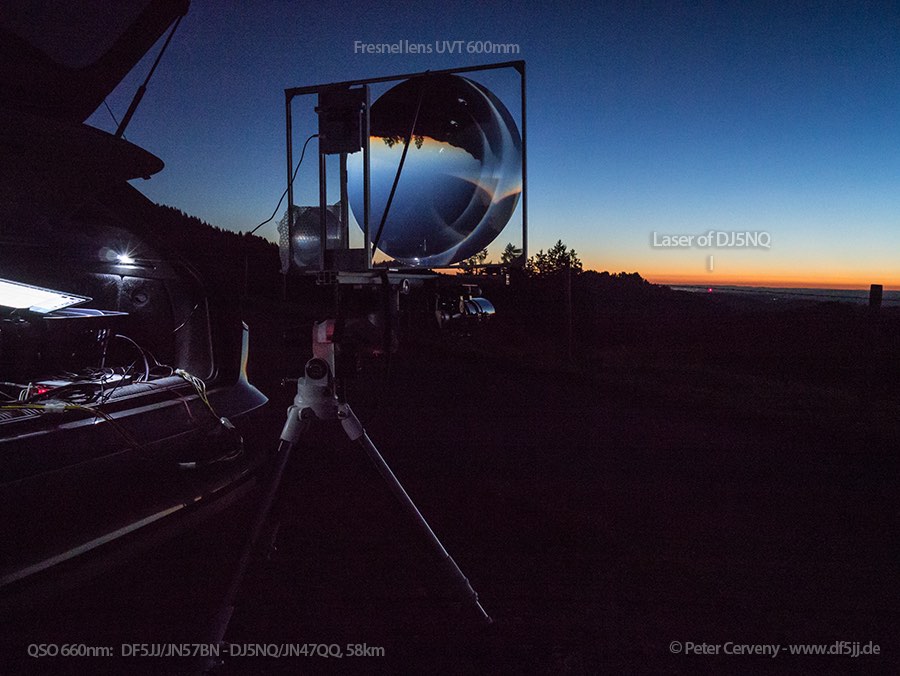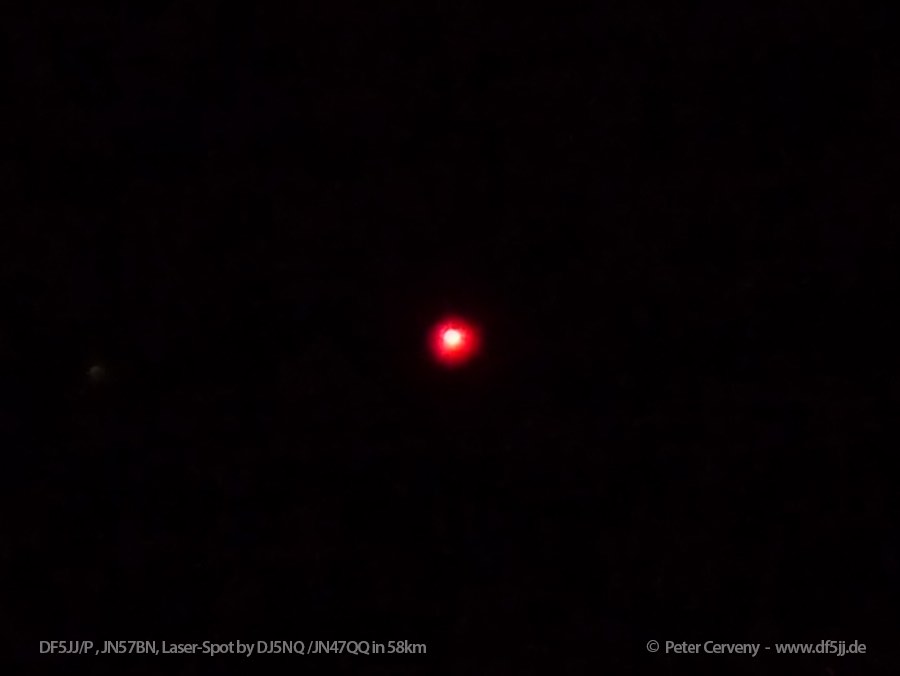Laser Light Communication
RIG of DF5JJ, Peter Cerveny, JN57BN, 1120m ASL
Ant. D=600mm F=600mm UVT Fresnel lens (>90% from 385-1100nm, >80% at 340nm, 50% at 290nm)
Meade LXD-75 Mount, QTF tracking accuracy AZ=0.016° EL=0.025°
TX UV: 385nm LED 0.5W out
50% into 0.2° beamwidth, 100% into 0.3° BW (secondary lens)
TX VIS: 660nm LED 3W out
50% into 0.4° beamwidth, 100% into 0.6° BW (secondary lens)
TX IR: 850nm LED 2.5W out
50% into 0.4° beamwidth, 100% into 0.6° BW (secondary lens)
RX: BPW34B frontend (KA7OEI design)
Interference bandpass filter 640-680nm for 660nm-operation
and highpass 800nm (>90% transmission) for IR-operation
RX/TX-Modes: AM, MCW, WSJT-X (tested down to -26dB in WSJT BW 2.4kHz)
Finder Scope: Fraunhofer-Refraktor D=80/F=400mm
with 23mm crosshair ocular
Finder Camera: Sony Super HAD CCD II Sensor, 1.4/50mm Nikkor,
limit sensitivity = 11.0mag star at 1 sec. exposure
Both aligned on the same optical bench with the fresnel.
Focal is adjustable for diverse focal points of UV/VIS/IR (accuracy/stability/repeatability <= 0.2mm).
The optical bench with its fresnel is collapsible for transportation.
Talkback: 145/433MHz FM, 5W and GSM cell phone
Check the local webcams/weather maps for light path condx here on my website.
73 es see you on UV-VIS-IR.
 Initial test of the 600mm fresnel lens in April 2016:
Initial test of the 600mm fresnel lens in April 2016:
Focussing the 385/660/850nm TX-heads and align cam/finderscope with the fresnel
 Star test with fresnel lens:
Star test with fresnel lens:
Blur circles of 450/550/660nm spectrum of star Arktur (mag -0.04).
Weaker stars resulted in bluir circles of <=0.5mm.
Cloud scatter test with LED-TX-head running 1W out (30%PWR) at D=600mm F=600mm UVT Fresnel lens.
The clouds reflect amber colour of Sodium lamps of the cities of the valley of Oberstdorf. The red beam appears wide in front of the fresnel due to the camera mounted only one meter off-axis of the 60cm-diameter parallel beam (LED 2x2mm square) and it ends in a visible square on the cloud. It was easy to set the focal lenght of the fresnel for sharpest spot on the cloud.
The distance of the dissolving Nimbostratus (NS) formations was about 8km.
The two bright stars on top are from Andromeda constellation.
The flag of my neighbour´s shop is a new blue one (previous flag was red, so no false colour of the photo).
 10.8.2016: Cloud scatter test with LED-TX-head 1W out
10.8.2016: Cloud scatter test with LED-TX-head 1W out
23. August 2016, 19:00 UTC
DF5JJ / DJ5NQ 2-Way-AM-QSO 660nm over 57.942km,
RST 59++/59+, S/N >=80dB RX saturated!
Further tests after QSO:
DF5JJ sent 660nm (Red) AM phonie down to 20mW - RST 52 at DJ5NQ
DF5JJ sent 850nm (IR) AM phonie down to 20mW - RST 55 at DJ5NQ
DF5JJ sent 385nm (UV-A) AM phonie full 0.5W - RST 21 at DJ5NQ (that time one-way-UV-worldwide record 57,9km)
All tests were done without talkback equipment!
Audio file of QSO DF5JJ/DJ5NQ, 58km, 660nm
DF5JJ received the Port Constance lightfire (JN47OP18) with excellent S/N=70dB (beam burst with 100Hz-modulation of the bulb) over 69.5 km.
The full unmodulated photon current was much stronger!
 Spectrum analyses by Spectrum Lab Software
Spectrum analyses by Spectrum Lab Software
Port Constance lightfire audio file
 Light-TRCVR in RX-mode copying laser of DJ5NQ (visible in the image)
Light-TRCVR in RX-mode copying laser of DJ5NQ (visible in the image)
 Laser spot of DJ5NQ/JN47QQ
Laser spot of DJ5NQ/JN47QQ
